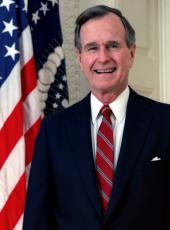
White House Fact Sheet: The Bush Administration's Policies for an American Technological Revolution
The President today met with the scientists, management, and workers at the world's largest science and engineering project, the superconducting super collider (SSC). He reaffirmed his continuing strong support of the Federal investment in this unprecedented scientific undertaking which will provide broad societal benefits.
The Problem
Technological innovation is essential to sustained economic growth. Those nations that innovate most successfully will compete best in an increasingly integrated global economy.
International competitiveness requires needed investments in basic research and efficiently commercializing the results of that research. It involves a technology policy that recognizes the important role of entrepreneurs and the need for flexibility in deploying resources to their most efficient uses.
The Bush Administration Principles
Since 1989, President Bush has aggressively pushed a strong science and technology agenda, and he has proposed devoting an unprecedented level of resources to R&D.
The President's science and technology agenda relies on six basic principles:
The private sector must be free to determine its own research priorities;
The Federal Government must promote sound tax policies that stimulate private sector investment in R&D and technological innovation;
The Federal Government must assure that its regulations do not impede firms from developing products or from bringing safe, new products to market;
The Federal Government must support a strong program of basic and applied R&D which provides broad societal benefits;
The Federal Government must work cooperatively with the private sector in the development of generic or enabling technologies;
Federally funded technology must be transferred swiftly and effectively to the private sector for commercialization.
The President has taken these six principles and developed a comprehensive strategy for enhancing America's technology prowess and competitiveness. It includes:
Opening up foreign markets to U.S. goods;
Accelerating technology transfer;
Investing in the future: Strengthening our knowledge base and increasing Federal support for emerging technologies;
Educating our students for a world of technology;
Coordinating with the private sector in consortia and other arrangements to develop generic or enabling technologies;
Stimulating private sector R&D through sound tax policies; and
Promoting technology through a sound regulatory system.
Opening Up Foreign Markets to U.S. Goods
The U.S. remains the world leader in the export of scientific and technological knowledge. Our high-tech exports have increased by two-thirds since 1987, and we enjoy a $37 billion trade surplus of high-tech exports with the rest of the world. The President is determined to maintain this position by opening new foreign markets and by protecting the intellectual property rights of those on the leading edge of scientific and technological innovation.
1. Bilateral Agreements With Japan. The administration has opened Japanese markets to U.S. high-tech goods through trade agreements covering supercomputers, satellites, semiconductors, and amorphous metals.
2. Intellectual Property Rights in the Uruguay Round. The administration is currently negotiating to ensure that the U.S. science and engineering base is protected from foreign pirating of technology.
3. North American Free Trade Agreement (NAFTA). The administration is completing the negotiations on the NAFTA which will open new opportunities for American exporters and the free flow of investment capital into the technologically intensive fields of the environment, medicine, agriculture, electronics, and telecommunications.
4. U.S./Asia Environmental Partnership. This unprecedented coalition of U.S. and Asian government units, businesses, and community groups is working together to enhance Asia's environment. This will result in the greater export of American technological know-how and equipment.
Accelerating Technology Transfer
The Federal Government has invested billions of dollars in creating the world's finest, most advanced research laboratories. This valuable national resource can assist civilian research efforts to investigate and develop commercially viable technologies.
Technology Transfer. The FY 1993 budget proposes a significant increase in technology transfer activities, including almost 1,500 cooperative research and development agreements (CRADA's) between Government laboratories and private industry, an increase of 60 percent over the past 2 years; approximately 4,500 new invention disclosures; 2,000 patent applications; and almost 300 technology licenses awarded.
The Administration's National Technology Initiative. Ten conferences have been held across the country, and five more are scheduled between now and December 1, 1992. These conferences act as catalysts for creating new partnerships among Government, universities, and American companies to better translate new technologies into marketable goods and services. A list of the conferences is attached.
Expanding the Role of the National Laboratories. The FY 1993 budget proposes that national laboratories play a greater role in high priority areas of civilian applied R&D by helping to form R&D consortia and other collaborative arrangements led by industry and academia.
George Bush, White House Fact Sheet: The Bush Administration's Policies for an American Technological Revolution Online by Gerhard Peters and John T. Woolley, The American Presidency Project https://www.presidency.ucsb.edu/node/268180
